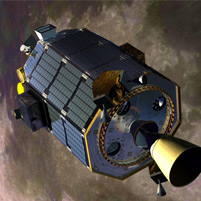The Sky Isn't the Limit


Jason Lohn
While some might claim their aspirations are out of this world, Jason Lohn means it. The Carnegie Mellon University–Silicon Valley professor's communication antennas are headed to the moon as part of NASA's latest mission, the Lunar Atmosphere and Dust Environment Explorer (LADEE), launched September 6.
The robotic LADEE mission is gathering information about the lunar atmosphere, surface conditions and environmental impact on lunar dust in an effort to increase understanding of the moon and other planetary bodies. Lohn's antennas will relay this data back to earth.
Lohn has developed software that employs artificial intelligence (AI) to design superior antennas. The resulting devices are more sensitive, better performing, smaller, lighter and less expensive to manufacture. They're also highly unusual.
"Because the antennas are designed by AI, they're unlike anything that a human antenna designer would come up with," explained Lohn, associate research professor of Electrical and Computer Engineering and director of the Carnegie Mellon Innovations Lab. "They're very striking and unique, with an appearance that appears random."
The AI-designed antennas often outperform human designs due to these complex, asymmetric shapes that can't be created using manual methods.
It's not the first NASA mission in which Lohn has participated. In 2006, he led a team that deployed three AI-designed antennas in space aboard the Space Technology 5 mission.
Just last June, his communication antennas were on board NASA's Interface Region Imaging Spectrograph (IRIS) mission. They relayed data regarding activity in the sun's lower atmosphere, examining the movement of solar material and energy between the surface and the corona.
The IRIS antennas were developed through Lohn's company, X5 Systems, a CMU spinoff founded in 2008. X5 Systems is a software-based company utilizing advanced optimization algorithms for antenna design.
Lohn joined the CMU-SV faculty in 2007, excited to become part of the new campus.
"I liked the idea that the Silicon Valley campus was in startup mode," said Lohn. "It was a chance to make a big difference, to have an impact. I'd known of Carnegie Mellon and its stellar reputation and it was a great opportunity I couldn't turn down."
He was also drawn by the school's entrepreneurial culture.
"The entrepreneurial spirit at CMU was a big attraction," he said. "When I came here, I felt that my antenna technology would reach the point of spinoff and believed CMU's entrepreneurial culture would be supportive."
He was completely right.
"I've gotten great support from CMU — the department, the college, and the university administration," said Lohn. "It's just been wonderful."
Top photo: Artist's rendering of NASA's LADEE spacecraft preparing to fire its maneuvering thrusters. NASA Ames/Dana Berry.
![]()
Related Links: Carnegie Mellon University - Silicon Valley | Carnegie Mellon Innovations Lab | Electrical & Computer Engineering
